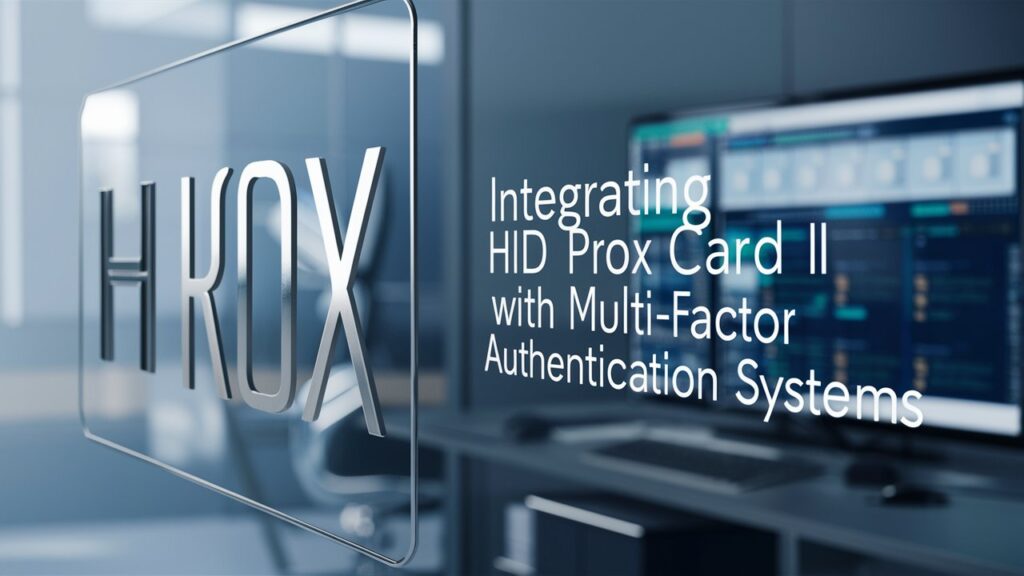While HID Prox Card II has long been a cornerstone of physical security systems, its standalone use is increasingly viewed as insufficient. Organizations across industries are now looking to bolster their defenses by integrating these familiar 125 kHz proximity cards with multi-factor authentication (MFA) systems.
This integration (that Bristol ID Technologies is leading in) isn’t just about adding layers of security—it’s about leveraging existing infrastructure while addressing known vulnerabilities. The HID Prox Card II, with its 137 billion unique codes and 6-inch read range, offers a solid foundation. However, issues like card cloning and tailgating have pushed security professionals to seek more robust solutions.
Enter multi-factor authentication. By combining the physical HID proximity cards with additional verification methods—be it PINs, biometrics, or mobile credentials—organizations can create a more resilient security posture.
Know The Card In Your Hand
This little powerhouse is a staple in the world of access control systems, and for good reason.
The HID Prox Card II operates at a frequency of 125 kHz, making it compatible with a wide range of readers. It boasts a read range of up to 6 inches, striking a balance between convenience and security. One of its standout features is its support for formats up to 85 bits, allowing for a staggering 137 billion unique codes. Talk about options!
Proximity card manufacturers construct these from durable PVC, these cards can take a beating while still looking professional. Many organizations opt for custom printing to add branding or additional visual security features.
Read More Articles: Impact of ISO PVC Proximity Cards on Long-Term Cost Efficiency?
Multi-Factor Authentication: The Basics
Now that we’re familiar with HID proximity cards, let’s talk about multi-factor authentication. MFA layers different types of verification to make sure you’re really you.
Typically, MFA systems use a combination of these factors:
- Something you know (like a password or PIN)
- Something you have (such as a security token or card)
- Something you are (biometrics like fingerprints or facial recognition)
By requiring users to provide at least two of these factors, MFA significantly raises the bar for potential intruders.
Bringing It All Together: HID Prox Card II and MFA
So, how do we marry the tried-and-true HID Prox Card II with modern multi-factor authentication systems? There are several ways to make this power couple work, both for physical and logical access control.
Physical Access Control
When it comes to securing physical spaces, integrating HID prox card with MFA can create a formidable barrier against unauthorized entry. Here are some popular combinations:
- Card + PIN: This classic duo requires users to present their HID Prox Card II and enter a PIN at the door reader. It’s simple, effective, and easy for users to understand.
- Card + Biometric: For higher security areas, combining the card with a fingerprint or facial recognition scan adds an extra layer of certainty.
- Card + Mobile: This modern approach pairs the physical HID access control cards with a mobile credential on the user’s smartphone. It’s convenient and leverages technology most people already carry.
Logical Access Control
An HID proximity card is’nt just for opening doors. They can also play a crucial role in securing digital assets. Here’s how:
- Card + Password: By using a USB card reader, employees can use their HID Prox Card II to authenticate to workstations alongside a traditional password.
- Card + OTP: Combining the card with a one-time password generated on a mobile app creates a strong, dynamic authentication process.
- Card + Smart Card: Some organizations opt for multi-technology cards that combine HID Prox capabilities with smart card features, offering flexibility and enhanced security.
The Perks of Integration
Integrating HID Prox Card II with MFA systems isn’t just about following the latest security trend. It offers tangible benefits:
- Significantly enhanced security compared to single-factor authentication
- Ability to leverage existing HID Prox Card II infrastructure
- Flexible options to meet varying security needs across an organization
- Improved user experience compared to relying solely on passwords
Making It Happen: Implementation Considerations
Ready to take the plunge? Here are some key points to consider when implementing this integrated approach:
- Choose compatible readers that support both HID Prox and additional authentication factors.
- Implement a robust credential management system to issue and track cards effectively.
- Ensure smooth integration with existing identity and access management systems.
- Provide thorough training to users on new authentication procedures.
- Consider a gradual rollout to minimize disruption and allow for adjustments.
Read More Articles: How to Integrate HID Prox Cards into Your Existing Security System
Looking Ahead: Advanced MFA Options
While HID Prox Card II integration offers solid security benefits, some organizations may require even higher levels of protection. In these cases, it’s worth exploring newer HID technologies:
- iCLASS SE: This technology supports high-frequency smart cards with advanced encryption, offering a step up in security.
- Seos: Enables mobile credentials and supports multiple applications on a single credential, providing ultimate flexibility.
These advanced options offer stronger cryptographic protection and more diverse authentication possibilities when integrated with MFA systems.
Staying Compliant: Regulatory Considerations
Implementing MFA with HID proximity cards can help organizations tick boxes on various regulatory requirements. Here are a few examples:
- HIPAA for healthcare organizations
- PCI DSS for businesses handling payment card data
- NIST guidelines for government agencies
It’s crucial to consult specific industry regulations when designing your MFA solution to ensure full compliance.
Wrapping It Up
Integrating HID Prox Card II with multi-factor authentication systems offers a powerful way to enhance security while leveraging existing infrastructure. By combining the reliability of HID proximity cards with the added protection of MFA, organizations can create a robust defense against unauthorized access.
Whether you’re securing physical spaces or digital assets, this integrated approach provides flexibility, improved user experience, and peace of mind. As security threats continue to evolve, the combination of HID Prox Card II and MFA stands ready to meet the challenge. Just know you should get yours only from a company you know you can trust, someone like Bristol ID Technologies.



